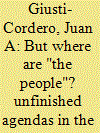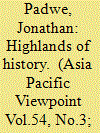| Srl | Item |
| 1 |
ID:
109978


|
|
|
|
|
| Publication |
2011.
|
| Summary/Abstract |
The People of Puerto Rico is a comprehensive ethnography of major types of rural communities in pre-1950 Puerto Rico but was less successful in reconnecting those localities in a coherent portrayal of the island's social formation. A reexamination of this work's best-known subcultures, Santa Isabel (Sidney Mintz' "Cañamelar") and Ciales (Eric Wolf's "San José"), offers entry points to these communities, as well as to the key concepts that Mintz and Wolf constructed reciprocally through their research: rural proletarian and peasant, plantation and hacienda. Also present are the too-implicit spatial referents of these concepts-lowland and highland, foreland and hinterland-and their associated crop types, sugar and coffee. In this article, the historical space of Santa Isabel and Ciales will be reconsidered, in part with reference to often-overlooked nuances and caveats in Mintz' and Wolf's chapters. Foregrounding the spatial/ecological referent in "Cañamelar" and "San José" opens our sights to counterpoints between sugar and livestock, and to patterns of highland-lowland migration, kin networks, and social interaction. Familiar concepts take on new meanings as we discern supra-municipal, sub-insular, and intermediate island regions and move closer to specifying historical situations (Mintz) while renewing our theorization (Wolf).
|
|
|
|
|
|
|
|
|
|
|
|
|
|
|
|
| 2 |
ID:
127084


|
|
|
|
|
| Publication |
2013.
|
| Summary/Abstract |
The notion that Cambodia's highland people may claim a distinct 'Indigenous' identity has emerged only recently in Cambodia. To date, advocacy for rights under the banner of indigeneity has produced few results for highlanders. Among the problems faced by advocates for Indigenous rights, problems of definition and translation represent an important challenge. Arguing that concepts like 'Indigeneity' are not simply adopted ex nihilo in new settings, but are rather incorporated into existing structures of meaning, this paper explores culturally produced understandings of who highlanders are, concentrating in particular on the way that the term 'Indigenous' has been translated into Khmer. The use of the Khmer word daeum, or 'original', to distinguish between Indigenous and other forms of ethnic belonging in the newly derived translation of 'Indigenous Peoples' points to historically sedimented beliefs about highlanders as living ancestors of modern Khmers.
|
|
|
|
|
|
|
|
|
|
|
|
|
|
|
|